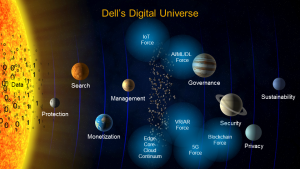The four fundamental forces of physics (gravitational, electromagnetic, the weak and the strong nuclear forces), which regulate everything in our universe from the galaxy down to the particle, were created shortly after the Big Bang.

Yet, it remains a mystery how they specifically function. There is a fifth force that might exist, which is shrouded by even greater mystery: dark energy, which is not dark and it only acts as a hypothetical thing indicating that the universe is expanding at an accelerating rate.
Why am I mentioning all of these things? Dell is using the forces of the universe as the basis to design its own digital universe. In it, there are far different forces at work, like IoT, VR, blockchain, and AI, and our planets Jupiter, Mars, and Saturn have been recast as governance, management, and security. Just like in the real world, everything in Dell’s digital universe interacts with everything. The only difference to the real world is that there is an explanation for everything and everything can be proven.
By the way, AI plays a crucial role here. It’s the only ‘force’ that can further develop itself; likewise, it can improve other technologies and drive innovation the fastest. It gives ‘flight’ to the other forces, much like the Higgs boson does with other particles in the real world by giving them mass. Nothing would work here with Higgs boson and nothing would work in today’s IT without AI either.
But AI is not a pipe dream like many still believe. There are many specific examples of how AI can optimize a company’s processes already. For example, MasterCard has implemented the technology to track down cases of credit card fraud. It would not be possible to tackle this type of fraud properly if it weren’t for artificial intelligence. Criminal activity increases by 50 percent every year and is becoming a tremendous problem. MasterCard can track payment patterns using machine learning detecting any anomalies. They could do this before but it goes much faster now through the combination of AI and big data. And there’s more: People’s shopping habits are translated into rules and added to the existing AI algorithms so they become increasingly effective. And the best part of this approach is that customers do not feel like someone is spying on them. They even welcome the technology because in the end MasterCard is protecting their digital identity.
There are many other examples of AI in use today: The University of Pisa uses the technology to predict the success of cancer treatments. The agricultural company Aerofarms has reduced water consumption for growing vegetables by 95 percent through vertical farming in warehouses and productivity of this type of agriculture has skyrocketed by a factor of 390. And McLaren uses AI in autonomous driving applications for real-time detection of objects, calculating 3D positions, and generating 3D images, for example.
Not only does AI improves the existing processes, it also optimizes the algorithms itself, meaning that the already improved processes are improved upon. AI is more than just a central technology. It also becomes a part of a business model and an important requirement for competitiveness in future markets.
